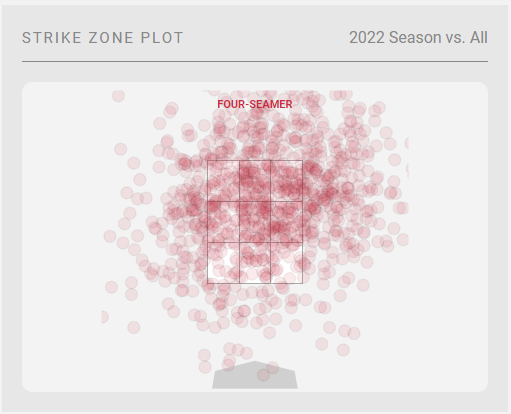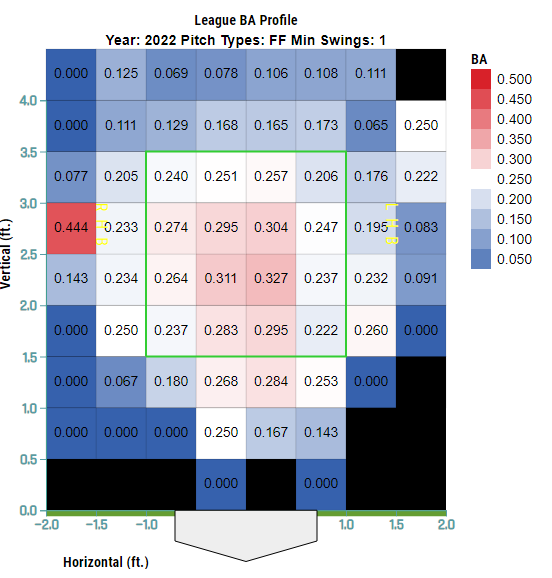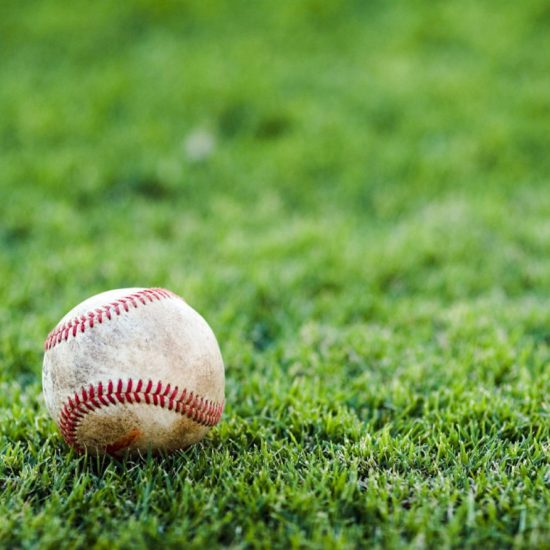It’s the top of the first, in a 2-2 count and 1 out, on a mid-May day in the nation’s capital. You sit, tucked into warm leather, before being gripped around your stitches and hurled 60 feet, 6 inches in the direction of All-Star SS Trea Turner. As you get closer to your target, you notice that everything around seems to slow down. You’re spinning on your x-axis at 2130 rpms but it’s no matter, as Turner’s bat makes contact with you and lofts you deep into the Washington twilight behind centerfield. You are a Josiah Gray fastball and you’ve gone on this journey 37 other times.
https://gfycat.com/blankweepybuckeyebutterfly
But it doesn’t have to be like this. Josiah Gray wasn’t supposed to be a HR Derby pitching machine. He was supposed to be another triumph of the Dodgers’ hallowed prospect development pipeline. So how did we get here? And can Gray turn it around at all?
Fastball Problems
After a season and a half at the major league level, things have not gone according to plan for Gray. He allowed 19 HRs allowed in 70 IP during the 2021 season, and then gave up 2x that amount in a little more than double the number of IP in 2022. All of this after 3 excellent minor league seasons in which he didn’t give up double digit home runs, combined. His 4-Seam fastball, previously receiving almost consensus 60 grades (Baseball America named him owner of the “Best Fastball” in the Dodgers org in ‘21), was responsible for 63% of his homers allowed last season. His FIP (5.86) and xFIP (4.57) would’ve ranked worst and second worst respectively, in the league, had he qualified.
But why are major league hitters teeing off on the offering? Is it velocity? In 2022, Gray’s 4-seamer measured above the 50th percentile in velocity & movement so it’s slightly better than average. Maybe it’s just a story of poor command/control, a young pitcher unable to locate his fastball and leaving it middle in for big league hitters to crush? Looking at his pitch heat map, it’s deployed rather conventionally, mostly up in the zone (with some slight run against LHH).

It’s a head-scratcher… until we look closer.
I mentioned that Gray throws this pitch 40% of the time, digging into his pitch arsenal by count, Gray is overly reliant on the 4-seam to both start the AB as well as to bail him out in hitter’s counts (throwing it 4% above league average when behind in count). Leaning that much on a single pitch, it better be elite at generating swinging strikes because hitters will obviously catch onto Gray’s sequencing. Here’s where we start to see a major indicator of why this pitch is catnip to batters: they take the pitch a fair amount, and when they do swing, they don’t miss it.


What’s the Good News?
That’s a pretty bleak picture, so why am I bothering to write about Gray?
Luckily for Gray, he has 2 other pitches of significance and relying on his secondaries more often could help deliver better results. Let’s talk about Gray’s breaking balls, starting with his curveball. Thrown about 25% of the time last year, Gray’s curveball shows no elite signs as far as spin or break, but the results are night and day by comparison to the fastball: a wOBA that’s 200 points lower, 34.7% K rate, and oh yeah, only 5 home runs allowed.
Gray’s slider is even better. Again, roughly average by pitch quality metrics BUT…36% K rate and just 6 homers allowed. Here’s another lens to view the effectiveness of Gray’s slider vs. his 4-seamer: His run value changes from +22 (3rd worst Fastball RV among qualified pitchers) to -11 RV for Sliders, which puts him in the company of Shane Bieber, Gerrit Cole, and Tony Gonsolin).
What about his sinker and change-up? Neither are thrown heavily, each about 3% of the time. That leaves us with 3 pitches, 2 with pretty good results and 1 that stinks.
Entering the Shadow Zone
Knowing that all 3 pitches are rated average at best by PLV and other pitch quality metrics but generating different pitch results, I was curious where these results were taking place. Specifically, I wanted to focus on pitches on the edge of the strike zone, mystically named the “shadow zone” in Savant. It’s possibly the most valuable region for pitchers because the best pitchers can create swings & misses while gaining called strikes, along with minimizing contact. Essentially, it’s where pitchers work their magic. The following table is a look at CSW% and contact% on edge pitches by pitch type for Josiah Gray.
Josiah Gray 2022
Edge CSW% & Contact%
What we see at a micro level is that Gray’s secondary offerings far outpace his primary pitch in generating positive results for him. For some added context, Gray’s slider ranks him 13th best in the league by Edge CSW% (min: 200 pitches) and the curveball ranks 18th best. The fastball you ask? Tied for 143rd… yikes.
I Wonder? What If…? Let’s Try!
Any adult having provided an iota of childcare in the past 4-5 years should be familiar with this elementary school framework of the scientific method from Sesame Street. For our purposes, I wonder: what would happen if Josiah used his four seamer less? What if, instead of “establishing the fastball” early in counts leading to predictability, he actually used his above average breaking balls to disrupt rhythm and stole more strikes on the edges? Let’s try and find a pitcher who’s made this type of conversion.

Staying in the same division, Kyle Wright, fresh off of a career year at age 27, offers some lessons from which Gray could benefit to learn. Like Gray, Wright was a former high profile prospect, drafted #5 overall by Atlanta in 2017. And similar to Gray, Wright found himself getting bum-rushed by major league hitting to start his career. While Wright has never had the home run issue as bad as Gray, he did give up extremely hard contact in his first few seasons with the Braves, leading to some terrible results. But as we can see from the above chart, Wright started to make a change, word to Michael Jackson. Instead of throwing what was an inefficient fastball as his primary pitch (5.15 Pitch Level Average in 2022) like in previous seasons, he led with his best pitch, the curveball, throwing it 34% and generating a SwStr rate of 17%. As Wright intentionally changed his usage, he saw his results improve. Remember our chart on Edge CSW% and Contact%?
Kyle Wright 2022
Edge CSW% + Contact%
If Gray were to throw at a similar usage rate, there’s little reason that a similarly positive development couldn’t occur for him.
What Does It All Mean?
In today’s age of pitching science, pitch quality is the name of the game. Not just throwing hard but having pitches with the spin, break, and release points to be optimized at the major league level. Josiah Gray was once thought to possess pitches, specifically a 4 seam fastball, that checked those boxes. With close to 4,000 pitches thrown in the majors, it appears more likely that Gray’s pitches are closer to league average in terms of quality. But not having elite quality doesn’t mean you can’t achieve elite results. This is where the science of pitching turns into an art. As pitchers mature, learning hitter tendencies as well as their own strengths and weaknesses, those who perform at a high level lean on their game plans and sequencing, as much as their raw stuff.
For Gray, his breakout seems to lie in how much he’s willing to forgo using his 4-seam fastball as his primary pitch. It’s a difficult ask of a 25 year old, the bulk of Gray’s success as an amateur and minor league prospect was built off of that fastball. It would be ridiculous to expect him to completely ditch the pitch, especially this early in his career. But by throwing his best pitches (slider and curveball) earlier and more frequently, the indicators that point to increased CSW, specifically on the edge of the zone. That increase of “edge CSW” is a key factor in stealing strikes early in counts, putting hitters at more of a disadvantage. More uncomfortable at bats should lead to a reduction in home runs (though he will still remain a flyball pitcher), reversing Gray’s reputation as a “Cherry Bomb”.
We tend to say that player development isn’t linear but it’s an adage that’s hard to keep in mind with highly rated prospects. But Josiah Gray is a reminder that finding the way to harness your full potential isn’t always black & white.


Nice article! Really enjoyed reading it!
Glad you enjoyed it, thanks for reading!
I’d also like to see him mix in the sinker a bit more. Not that it was great, but he only started using it the latter part of last year. Could help reduce the fly balls early in the count.
Definitely would be interesting to see if he worked the sinker or some general 2-seamer into the mix more. But as you noted, what he showed us wasn’t that impressive. I think the next best step for Gray is leaning into his best pitches first (Slider, Curve). Thanks for reading!